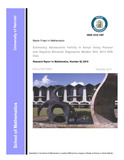| dc.description.abstract | Due to non-functioning and incomplete vital registration systems in many developing countries, estimates of adolescents‟ fertility rate is by indirect methods which derive data from retrospective information obtained during national housing censuses which are conducted every ten years, or from specialized demographic sample surveys conducted quinquennially. Generally, most indirect estimation methods are characterized by: reliance on historical data which may suffer from recall errors, large volume of data requirements, low quality data, high data collection costs and application difficulties in the field. The indirect methods are developed not as a possible replacement of direct methods, but rather as temporary tools for measuring fertility aspects of the population where systems for registration of vital events do not exist or are too incomplete to be directly useful. Different methods have been advanced to calculate the ASFR metric, each with a different result.
This study seeks to estimate and compare adolescents‟ birth rate using the Poisson and negative binomial generalized linear regression models and to establish the reliability of the techniques in producing differential effects from socio-economic characteristics that influence teenage pregnancy. The study will use the birth histories of adolescents age 15-
19 years derived from the 2014 DHS data for Kenya.
By use of the Akaike Information Criteria (AIC) and the Bayesian Information Criteria (BIC), the results showed that the Poisson regression model; AIC (1737.542) and BIC (1878.325) presented a comparatively better fit in modeling the differential effects than the negative binomial regression model; AIC (1813.856) and BIC (1954.639). The estimated ASFR for the Poisson model was 88 births per 1000women while that of the negative binomial model was 86 births per 1000 women, in comparison to the national ASFR estimate of 96 births per 1000 women. For further research, it is recommended to compare the Poisson regression model with other models that estimate under-dispersion in count data as well as further detailed analysis through variable reduction. | en_US |



